Beauty in the Macabre
Beauty in the Macabre
Special customs of the Bodo death rites
The Bodos belong to the great Mongoloid stock of man. According to history, the Bodos were permanent 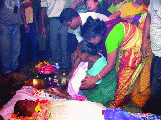 inhabitants of Mongolia but in the course of time, their forefathers left their original abode group by group for other parts of the world in search of more fertile land and they finally settled permanently all over the northeastern region of India primarily in Assam, Arunachal Pradesh, Nagaland, Manipur, Meghalaya, Tripura and the northern parts of Bihar and West Bengal.
However, the Bodos were concentrated in the districts of BTC (Bodoland Territorial Council) namely Kokrajhar, Chirang, Baska and Udalguri. They are also found in other districts like Goalpara, Lakhimpur, Sonitpur, Dhemaji, Nowgaon, Morigaon, Karbi – Anglong and even in India’s neighbouring countries like Bhutan and Nepal.
inhabitants of Mongolia but in the course of time, their forefathers left their original abode group by group for other parts of the world in search of more fertile land and they finally settled permanently all over the northeastern region of India primarily in Assam, Arunachal Pradesh, Nagaland, Manipur, Meghalaya, Tripura and the northern parts of Bihar and West Bengal.
However, the Bodos were concentrated in the districts of BTC (Bodoland Territorial Council) namely Kokrajhar, Chirang, Baska and Udalguri. They are also found in other districts like Goalpara, Lakhimpur, Sonitpur, Dhemaji, Nowgaon, Morigaon, Karbi – Anglong and even in India’s neighbouring countries like Bhutan and Nepal.
“The Bodos, earlier known as ‘Kachari’ are a Hinduised Tribe of Tibeto – Mongoloid origin. Their language was identified as one of the major languages of the Tibeto – Burman family. The other neighbouring communities which belong to the same linguistic family are Dimasas, Kachari, Rabha, Tiwa, Tippera, Sonowal Kachari, Missings, etc. This is one of the oldest and most dominant communities of the Assam plains. This community stayed peaceful with neighbouring Assamese and non – Assamese communities and shared many cultural traits and behaviour” (Sucheta Sen Choudhury: The Bodo Movement and Women’s participation, 1st edition: 2004, P-16)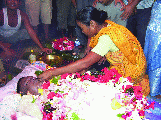 The word ‘Bodo’ was first used by the European scholar, Hudgson to refer to a group of languages of the Mongoloid race and Tibeto – Burman group of people inhabitating the hills and plains of the entire northeastern region of India.
The word ‘Bodo’ was first used by the European scholar, Hudgson to refer to a group of languages of the Mongoloid race and Tibeto – Burman group of people inhabitating the hills and plains of the entire northeastern region of India.
The system of cremation of a deceased person of the Bodo society is noteworthy. Generally, the body of the deceased is taken out from the house and kept in the middle of the courtyard. Before laying out the dead body, the south corner of the courtyard is cleaned with water. If the deceased is a male, the body is then dressed in a new gamcha and if the deceased is a female, a new Dokhana is used. The body of the deceased person is then placed in such a way that the head is towards the south. If the deceased is a married male, then his wife will show her last respects by kneeling down and removing her ‘sindur’ (vermilion) with the help of the toe of the right leg of the deceased person. Then other members of the family as well as the relatives will offer food, one after the other to the deceased.
If the deceased is a married woman, two spots of sindur are then put on the forehead of the deceased and if she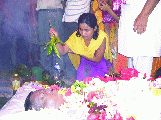 is unmarried only one sindur is used. “The dead body is placed on a Sangra which is a kind of trellis made of raw bamboo. The projecting bamboo poles which rest on the shoulders of the pallbearers are called ‘Bathi’. The pallbearers are called ‘Gwthoi Bangra’. Generally the corpse is carried away by the sons or the relatives to the cremation ground. In the villages, at least one male member from each family is expected to make an appearance at the house where the death has occured. The procession is led by the Deori (priest). According to the belief, a deceased individual needs a few things for the journey after death. Those who accompany the deceased person to the cremation ground show their last respects by sprinkling a few drops of water on the dead body with the help of the leaves of the fig tree (Phakhri Bilai)
is unmarried only one sindur is used. “The dead body is placed on a Sangra which is a kind of trellis made of raw bamboo. The projecting bamboo poles which rest on the shoulders of the pallbearers are called ‘Bathi’. The pallbearers are called ‘Gwthoi Bangra’. Generally the corpse is carried away by the sons or the relatives to the cremation ground. In the villages, at least one male member from each family is expected to make an appearance at the house where the death has occured. The procession is led by the Deori (priest). According to the belief, a deceased individual needs a few things for the journey after death. Those who accompany the deceased person to the cremation ground show their last respects by sprinkling a few drops of water on the dead body with the help of the leaves of the fig tree (Phakhri Bilai)
Disposal of the dead body.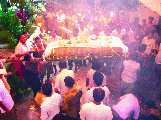 There are two types by which the dead body is disposed of in Body society. These are:
There are two types by which the dead body is disposed of in Body society. These are:
Burial System - In the early days, the Bodos generally preferred the burial system of disposing a dead body. Even today, this system is practised in many places. In this system, the body is covered with a white cloth and slowly lowered into the grave with the head towards the south. A few coins and cowrie shells are also buried along with the body. It is said that thee soul of the deceased person may be required to cross a river by boat and these coins can be used to pay the fare to the boatman and also the soul may need to purchase some food on his journey.
A small hole is left in the earth which allows air to reach the nose of the buried person. It is believed that by doing so, the spirit of the dead entering the body is helped to breathe. A pitcher full of fresh water is placed on the grave as a drink for the dead. A little rice is also coked out on the spot of burial and is left for the deceased. It is believed that the soul of the dead may start its journey after partaking of this rice.
All the people who accompany the dead body to the cremation ground are supposed to take a bath in the river or pond before going back home and they touch or chew the Narzy – gwran. By doing so, the mourners signify that they have separated their relationship with the dead person from that day forth. Thereafter, a piece of red thread is placed on the lips of the dead body. It is believed that on placing this piece of thread on the lips, the deceased will have red lips upon being reborn. The Bodos believe that as a result of using leaves of the Indian fig tree, the lips of the deceased become small and thin upon rebirth. A branch, full of leaves of this same tree is planted at the head of the grave of the burial ground. This practice has a deep significance. According to their belief, by doing so, the dead person will have beautiful hair upon being reborn. If the person is a male, his soul will rest under the fig tree until it attains salvation.
Cremation System – When the corpse of the deceased is to be disposed off by burning, a funeral pyre is 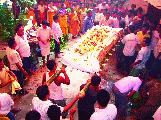 arranged. There is a system of placing five or seven stacks of wood while this funeral pyre is arranged. The relatives and friends of the deceased pass around the funeral pyre in a procession, the men five times around and the women seven.
arranged. There is a system of placing five or seven stacks of wood while this funeral pyre is arranged. The relatives and friends of the deceased pass around the funeral pyre in a procession, the men five times around and the women seven.
All the people who accompany the dead body to the cremation ground are supposed to take a bath in the river or pond before going back home and they touch or chew the Narzy – gwran (dry leaves of the jute plant). The Bodos believe that by doing so, the relation between the deceased and the funeral party is severed from that day forth. After returning from the rivers or ponds, the Deori (priest) sprinkles holy water on them for purification. Thereafter the members of the funeral party enter their respective houses after bowing down before the altar of the Bathou. The Brahma Dharma believers enter their respective houses only after purifying themselves with the holy water kept ready in front of their houses. Finally, they gather together at the house of the deceased after changing their attire at home. The funeral party is then entertained with Jumai (rice beer). Nowadays, tea is offered in place of Jumai at such occasions. At the house of the deceased, the people discuss the ‘shradha’ of the deceased person.
The shradha is generally held either on the eleventh or thirteenth day after the date of death. The villagers once again gather on the night prior to the shradha. This is known as ‘Daha’ or ‘Daha sarnat’ (Saradu) which means to give up grief. The Bodos of Darang district now called Udalguri district call this the ‘Gyati Jawnai’. The ceremony is performed simply by offering some of the favourite food to the deceased person. This is called ‘Gwthoinw Baonai’ (offering food to the deceased person). In this regard, the Deori plays an important role from the start to finish. The whole ceremony is conducted by him. On Saradu day, there is a traditional custom to feed the villagers and the relatives.
On the next day viz. on the Shradha day, the ceremony is performed by praying before the altar of Burai – Bathou in the traditional fashion. According to Bathou believers, the following functions are performed during the Saradu:
a. Phindu Garnai
b. Phaphli hwkhlai nai
c. Ishing baonai
Pindu Garnai – The Phindu Garnai is one of the most important functions to be performed by the Bodos during Saradu day. For this, all essential materials are made readily available prior to the Saradu. The head of the family of the deceased person who keeps Saradu should prepare the food for the deceased person and keep this ready. All these food items prepared should be kept inside a large ‘Kho’ (bamboo made) covered by a white cloth for the next morning. At dawn, all these food items are taken to the river or the cremation site for disposal. On reaching the destination, an altar is prepared for worshipping or offering the food items to the deceased person. In the eventuality that the deceased is a female, seven leaflets of the banana tree are placed on the altar and five if the deceased is a male. Four bamboo branches are planted on all four corners and all the four corners of the white piece of cloth should be tied up. One bamboo branch should be planted to the southern side of the altar where a piece of white cloth is tied up like a flag. A pitcher full of water is kept in the middle of the altar.
Phaphli hwkhlai nai – This customary function is observed during the Saradu day to show respect or honour to the people who carried the deceased person on their shoulders to the cremation ground. They are seated in one row on the Khamphlai (a low wooden stool without legs). The head of the family of the deceased person honours them with a pair of betel nuts, a pair of betel leaves and some coins. This is offered as the head of the family kneels down in front of them and begs for their pardon for any kinds of mistakes made by him beyond his knowledge. Their shoulders are then massaged with pure oil for seven times if the deceased is a female and five if the deceased is a male.
Ishing baonai – This customary function is also to be performed during the Saradu. A Khamphlai without legs is placed on an upper portion of banana leaves at the southern corner of the courtyard after it is washed. The Khamphlai is covered with a piece of white cloth and then a pair of betel nuts and a pair of betel leaves and also all the clothes used by the deceased person are placed on the cloth. Then all the members of the family of the deceased person show their respect by kneeling down for the last time. At that time, the Gwthari (priest) sprinkles holy water on them with a chant of Bathou manthwr.
On the Saradu day, the family of the deceased arranges for entertainment for their relatives, friends and the villagers with various food items. In early days, the villagers and the relatives of the deceased were entertained with jumai (rice beer) which was produced in abundance. Nowadays such type of entertainment has been abandoned by the All Bathou Religious Union. At present, only tea is offered at the Saradu ceremony. Similarly, serving of meat or fish like oma – bedor (pork), dao – bedor (chicken), etc. were also common in the Saradu ceremony. Nowadays, this kind of practice is also banned.
The most interesting and attractive aspect of the ceremony is the arranging of ‘Dan Sarnai’ performance. At the end of the entertainment, a custom of giving alms in the form of coins is followed. Generally, such coins are mixed with uncooked rice and are thrown in the air amidst a large gathering of children. This is known as Dan Sarnai where in the Bodo language Dan means alms and Sarnai means to give away. The responsibility of conducting the whole function rests on the eldest son of the deceased person if the deceaseded is a male. Otherwise, the whole function is arranged by the head of the family. Nowadays, of course, it is compulsory to offer some fixed quantity of rice, dal etc by each family of the village which strengthens unity and integrity among the villagers.
The followers of the Brahma Dharma perform Ahuti during the Shradha ceremony. As soon as the Ahuti is over, all people assembled at the function are entertained with a common meal. Serving of jumai during such a ceremony is totally restricted. However, jumai is sometimes served just after the main function including the Suwa garnai (removing of impurities) is over.
H. D. Boro


